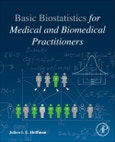Basic Biostatistics for Medical and Biomedical Practitioners, Second Edition makes it easier to plan experiments, with an emphasis on sample size. It also shows what choices are available when simple tests are unsuitable and offers investigators an overview of how the kinds of complex tests that they won't do on their own work. The second edition presents a new, revised and enhanced version of the chapters, taking into consideration new developments and tools available, discussing topics, such as the basic aspects of statistics, continuous distributions, hypothesis testing, discrete distributions, probability in epidemiology and medical diagnosis, comparing means, regression and correlation.
This book is a valuable source for students and researchers looking to expand or refresh their understanding of statistics as it applies to the biomedical and research fields. Based on the author's 40+ years of teaching statistics to medical fellows and biomedical researchers across a wide range of fields, it is a valuable source for researchers who need to understand more about biostatistics to apply it to their work.
Please Note: This is an On Demand product, delivery may take up to 11 working days after payment has been received.
Table of Contents
Basic Aspects of Statistics 1. Basic Concepts 2. Statistical Use and Misuse in Scientific Publications 3. Some Practical Aspects 4. Exploratory Descriptive Analysis 5. Basic Probability
Continuous Distributions 6. Normal Distribution 7. Statistical Inference: Confidence Limits and the Central Limit Theorem 8. Other Continuous Distributions 9. Outliers and Extreme Values
Hypothesis Testing 10. Hypothesis Testing: The Null Hypothesis, Significance and Type I Error 11. Hypothesis Testing: Sample Size, Effect Size, Power, and Type II Errors
Discrete Distributions 12. Permutations and Combinations; Logarithms 13. Hypergeometric Distribution 14. Categorical and Cross-Classified Data: Goodness of Fit and Association 15. Categorical and Cross-Classified Data 16. Binomial and Multinomial Distributions 17. Proportions 18. The Poisson Distribution 19. Negative Binomial Distribution
Probability in Epidemiology and Medical Diagnosis 20. Some Epidemiological Considerations: Odds Ratio, Relative Risk, and Attributable Risk 21. Probability, Bayes Theorem, Medical Diagnostic Evaluation, and Screening
Comparing Means 22. Comparison of Two Groups: T Tests and Non-Parametric Tests 23. T Test Variants: Cross-Over Tests, Equivalence Tests 24. Multiple Comparisons 25. Analysis of Variance. I One-Way 26. Analysis of Variance. II More Complex Forms
Regression and Correlation 27. Linear Regression 28. Variations Based on Linear Regression 29. Correlation 30. Multiple Regression 31. Serial Measurements: Time Series, Control Charts, Cusums 32. Dose-Response Analysis 33. Logistic Regression 34. Poisson Regression
Miscellaneous Topics 35. Survival Analysis 36. Meta-analysis 37. Resampling Statistics 38. Design: Sampling, Clinical Trials








